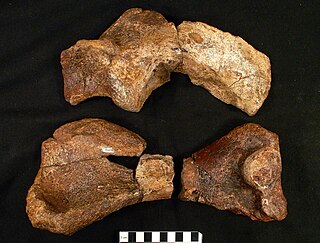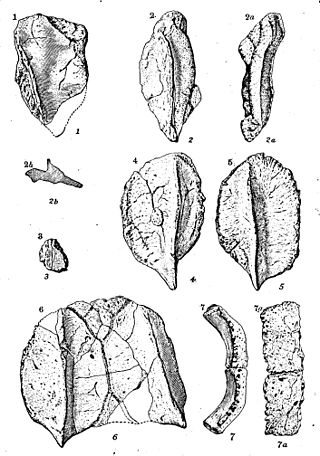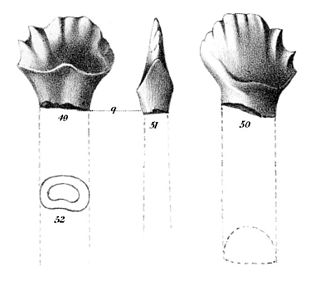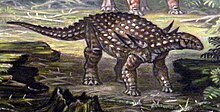
Animantarx is a genus of nodosaurid ankylosaurian dinosaur from the Early and Late Cretaceous of western North America. Like other nodosaurs, it would have been a slow-moving quadrupedal herbivore covered in heavy armor scutes, but without a tail club. The skull measures approximately 25 cm in length, suggesting the animal as a whole was no more than 3 meters long.

Edmontonia is a genus of panoplosaurin nodosaurid dinosaur from the Late Cretaceous Period. It is part of the Nodosauridae, a family within Ankylosauria. It is named after the Edmonton Formation, the unit of rock where it was found.

Gastonia is a genus of herbivorous ankylosaurian dinosaur from the Early Cretaceous of North America, around 139 to 134.6 million years ago. It is often considered a nodosaurid closely related to Polacanthus. Gastonia has a sacral shield and large shoulder spikes.

Hungarosaurus tormai, is a herbivorous nodosaurid ankylosaur from the Upper Cretaceous (Santonian) Csehbánya Formation of the Bakony Mountains of western Hungary. It is the most completely known ankylosaur from the Cretaceous of Europe.

Aletopelta is a monospecific genus of basal ankylosaurid dinosaur from Southern California that lived during the Late Cretaceous in what is now the Point Loma Formation. The type and only species, Aletopelta coombsi, is known from a partial skeleton preserving osteoderms. It was originally described in 1996 by W. P. Coombs, Jr. and T.A. Deméré before being named in 2001 by Tracy Ford and James Kirkland. Aletopelta has an estimated size of 5 metres and weight of 2 tonnes. The holotype formed a miniature reef and was scavenged upon by invertebrates and sharks.

Anoplosaurus is an extinct genus of herbivorous nodosaurid dinosaur, from the late Albian-age Lower Cretaceous Cambridge Greensand of Cambridgeshire, England. It has in the past been classified with either the armored dinosaurs or the ornithopods, but current thought has been in agreement with the "armored dinosaur" interpretation, placing it in the Ankylosauria.

Sauropelta is a genus of nodosaurid dinosaur that existed in the Early Cretaceous Period of North America. One species has been named although others may have existed. Anatomically, Sauropelta is one of the most well-understood nodosaurids, with fossilized remains recovered in the U.S. states of Wyoming, Montana, and possibly Utah. It is also the earliest known genus of nodosaurinae; most of its remains are found in a section of the Cloverly Formation dated to 108.5 million years ago.

Stegopelta is a genus of struthiosaurin nodosaurid dinosaur. It is based on a partial skeleton from the latest Albian-earliest Cenomanian-age Lower and Upper Cretaceous Belle Fourche Member of the Frontier Formation of Fremont County, Wyoming, USA.

Texasetes is a genus of ankylosaurian dinosaurs from the late Lower Cretaceous of North America. This poorly known genus has been recovered from the Paw Paw Formation near Haslet, Tarrant County, Texas, which has also produced the nodosaurid ankylosaur Pawpawsaurus.

Hierosaurus is an extinct genus of nodosaurid ankylosaur which lived during the Late Cretaceous 87 to 82 million years ago. Its fossils were found in the Smoky Hill Chalk Member of the Niobrara Formation, in western Kansas, which would have been near the middle of the Western Interior Sea during the Late Cretaceous. It was a nodosaurid, an ankylosaur without a clubbed tail.

Mymoorapelta is a nodosaurid ankylosaur from the Late Jurassic Morrison Formation of western Colorado and central Utah, USA. The animal is known from a single species, Mymoorapelta maysi, and few specimens are known. The most complete specimen is the holotype individual from the Mygatt-Moore Quarry, which includes osteoderms, a partial skull, vertebrae, and other bones. It was initially described by James Kirkland and Kenneth Carpenter in 1994. Along with Gargoyleosaurus, it is one of the earliest known nodosaurids.

Denversaurus is a genus of panoplosaurin nodosaurid dinosaur from the late Maastrichtian of Late Cretaceous Western North America. Although at one point treated as a junior synonym of Edmontonia by some taxonomists, current research indicates that it is its own distinct nodosaurid genus.

Pawpawsaurus, meaning "Pawpaw Lizard", is a nodosaurid ankylosaur from the Cretaceous of Tarrant County, Texas, discovered in May 1992. The only species yet assigned to this taxon, Pawpawsaurus campbelli, is based on a complete skull from the marine Paw Paw Formation.

Palaeoscincus is a dubious genus of ankylosaurian dinosaur based on teeth from the mid-late Campanian-age Upper Cretaceous Judith River Formation of Montana. Like several other dinosaur genera named by Joseph Leidy, it is an historically important genus with a convoluted taxonomy that has been all but abandoned by modern dinosaur paleontologists. Because of its wide use in the early 20th century, it was somewhat well known to the general public, often through illustrations of an animal with the armor of Edmontonia and the tail club of an ankylosaurid.
Dracopelta is a monospecific genus of ankylosaur dinosaur from Portugal that lived during the Late Jurassic in what is now the Lourinhã Formation. The type and only species is Dracopelta zbyszewskii, which is represented by a partial skeleton including unpublished material.

Antarctopelta is a genus of ankylosaurian dinosaur, a group of large, quadrupedal herbivores, that lived during the Campanian stage of the Late Cretaceous period on what is now James Ross Island, Antarctica. Antarctopelta is the only known ankylosaur from Antarctica and a member of Parankylosauria. The only described specimen was found in 1986, the first dinosaur to be found on the continent, by Argentine geologists Eduardo Olivero and Robert Scasso. The fossils were later described in 2006 by paleontologists Leonardo Salgado and Zulma Gasparini, who named the type species A. oliveroi after Olivero.

Glyptodontopelta is a monospecific genus of nodosaurid dinosaur from New Mexico that lived during the Late Cretaceous in what is now the Naashoibito member of the Ojo Alamo Formation. The type and only species, Glyptodontopelta mimus, is known from numerous specimens that consist of osteoderms, a dentary, supraorbital and bone fragments. It was named in 2000 by Tracy Ford. Edmontonia australis is a junior synonym of Glyptodontopelta.

Priconodon is an extinct genus of dinosaur, known from its large teeth. Its remains have been found in the Aptian-Albian age Lower Cretaceous Arundel Formation of Muirkirk, Prince George's County, Maryland, USA and the Potomac Group, also located in Maryland.
Priodontognathus was a genus of ankylosaurian dinosaur possibly from the Oxfordian-age Upper Jurassic Lower Calcareous Grit of Yorkshire, England. It is a dubious genus based on a maxilla, and has been erroneously mixed up with iguanodonts and stegosaurs.

This timeline of ankylosaur research is a chronological listing of events in the history of paleontology focused on the ankylosaurs, quadrupedal herbivorous dinosaurs who were protected by a covering bony plates and spikes and sometimes by a clubbed tail. Although formally trained scientists did not begin documenting ankylosaur fossils until the early 19th century, Native Americans had a long history of contact with these remains, which were generally interpreted through a mythological lens. The Delaware people have stories about smoking the bones of ancient monsters in a magic ritual to have wishes granted and ankylosaur fossils are among the local fossils that may have been used like this. The Native Americans of the modern southwestern United States tell stories about an armored monster named Yeitso that may have been influenced by local ankylosaur fossils. Likewise, ankylosaur remains are among the dinosaur bones found along the Red Deer River of Alberta, Canada where the Piegan people believe that the Grandfather of the Buffalo once lived.



















